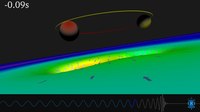
Photo from wikipedia
In this paper we present the potential of a new compact superconducting gravimeter (GWR iGrav) designed for groundwater monitoring. At first, 3 yr of continuous gravity data are evaluated and… Click to show full abstract
In this paper we present the potential of a new compact superconducting gravimeter (GWR iGrav) designed for groundwater monitoring. At first, 3 yr of continuous gravity data are evaluated and the performance of the instrument is investigated. With repeated absolute gravity measurements using a Micro-g Lacoste FG5, the calibration factor (−894.8 nm s−2 V−1) and the long-term drift of this instrument (45 nm s−2 yr−1) are estimated for the first time with a high precision and found to be respectively constant and linear for this particular iGrav. The low noise level performance is found similar to those of previous superconducting gravimeters and leads to gravity residuals coherent with local hydrology. The iGrav is located in a fully instrumented hydrogeophysical observatory on the Durzon karstic basin (Larzac plateau, south of France). Rain gauges and a flux tower (evapo-transpiration measurements) are used to evaluate the groundwater mass balance at the local scale. Water mass balance demonstrates that the karst is only capacitive: all the rainwater is temporarily stored in the matrix and fast transfers to the spring through fractures are insignificant in this area. Moreover, the upper part of the karst around the observatory appears to be representative of slow transfer of the whole catchment. Indeed, slow transfer estimated on the site fully supports the low-flow discharge at the only spring which represents all groundwater outflows from the catchment. In the last part of the paper, reservoir models are used to characterize the water transfer and storage processes. Particular highlights are done on the advantages of continuous gravity data (compared to repeated campaigns) and on the importance of local accurate meteorological data to limit misinterpretation of the gravity observations. The results are complementary with previous studies at the basin scale and show a clear potential for continuous gravity time-series assimilation in hydrological simulations, even on heterogeneous karstic systems.
Journal Title: Geophysical Journal International
Year Published: 2017
Link to full text (if available)
Share on Social Media: Sign Up to like & get
recommendations!